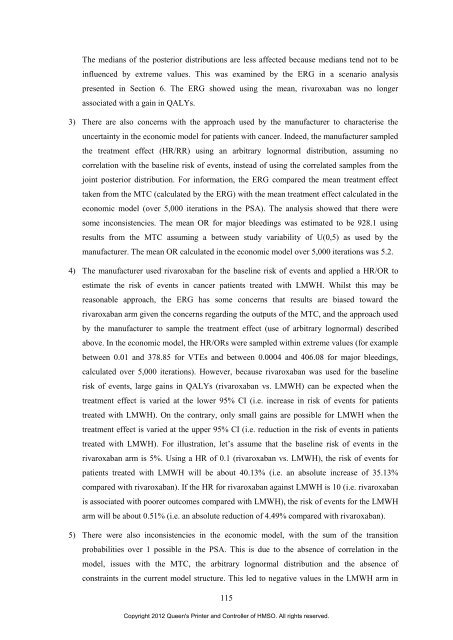Rivaroxaban for the treatment of deep vein thrombosis and ...
Rivaroxaban for the treatment of deep vein thrombosis and ...
Rivaroxaban for the treatment of deep vein thrombosis and ...
You also want an ePaper? Increase the reach of your titles
YUMPU automatically turns print PDFs into web optimized ePapers that Google loves.
The medians <strong>of</strong> <strong>the</strong> posterior distributions are less affected because medians tend not to be<br />
influenced by extreme values. This was examined by <strong>the</strong> ERG in a scenario analysis<br />
presented in Section 6. The ERG showed using <strong>the</strong> mean, rivaroxaban was no longer<br />
associated with a gain in QALYs.<br />
3) There are also concerns with <strong>the</strong> approach used by <strong>the</strong> manufacturer to characterise <strong>the</strong><br />
uncertainty in <strong>the</strong> economic model <strong>for</strong> patients with cancer. Indeed, <strong>the</strong> manufacturer sampled<br />
<strong>the</strong> <strong>treatment</strong> effect (HR/RR) using an arbitrary lognormal distribution, assuming no<br />
correlation with <strong>the</strong> baseline risk <strong>of</strong> events, instead <strong>of</strong> using <strong>the</strong> correlated samples from <strong>the</strong><br />
joint posterior distribution. For in<strong>for</strong>mation, <strong>the</strong> ERG compared <strong>the</strong> mean <strong>treatment</strong> effect<br />
taken from <strong>the</strong> MTC (calculated by <strong>the</strong> ERG) with <strong>the</strong> mean <strong>treatment</strong> effect calculated in <strong>the</strong><br />
economic model (over 5,000 iterations in <strong>the</strong> PSA). The analysis showed that <strong>the</strong>re were<br />
some inconsistencies. The mean OR <strong>for</strong> major bleedings was estimated to be 928.1 using<br />
results from <strong>the</strong> MTC assuming a between study variability <strong>of</strong> U(0,5) as used by <strong>the</strong><br />
manufacturer. The mean OR calculated in <strong>the</strong> economic model over 5,000 iterations was 5.2.<br />
4) The manufacturer used rivaroxaban <strong>for</strong> <strong>the</strong> baseline risk <strong>of</strong> events <strong>and</strong> applied a HR/OR to<br />
estimate <strong>the</strong> risk <strong>of</strong> events in cancer patients treated with LMWH. Whilst this may be<br />
reasonable approach, <strong>the</strong> ERG has some concerns that results are biased toward <strong>the</strong><br />
rivaroxaban arm given <strong>the</strong> concerns regarding <strong>the</strong> outputs <strong>of</strong> <strong>the</strong> MTC, <strong>and</strong> <strong>the</strong> approach used<br />
by <strong>the</strong> manufacturer to sample <strong>the</strong> <strong>treatment</strong> effect (use <strong>of</strong> arbitrary lognormal) described<br />
above. In <strong>the</strong> economic model, <strong>the</strong> HR/ORs were sampled within extreme values (<strong>for</strong> example<br />
between 0.01 <strong>and</strong> 378.85 <strong>for</strong> VTEs <strong>and</strong> between 0.0004 <strong>and</strong> 406.08 <strong>for</strong> major bleedings,<br />
calculated over 5,000 iterations). However, because rivaroxaban was used <strong>for</strong> <strong>the</strong> baseline<br />
risk <strong>of</strong> events, large gains in QALYs (rivaroxaban vs. LMWH) can be expected when <strong>the</strong><br />
<strong>treatment</strong> effect is varied at <strong>the</strong> lower 95% CI (i.e. increase in risk <strong>of</strong> events <strong>for</strong> patients<br />
treated with LMWH). On <strong>the</strong> contrary, only small gains are possible <strong>for</strong> LMWH when <strong>the</strong><br />
<strong>treatment</strong> effect is varied at <strong>the</strong> upper 95% CI (i.e. reduction in <strong>the</strong> risk <strong>of</strong> events in patients<br />
treated with LMWH). For illustration, let’s assume that <strong>the</strong> baseline risk <strong>of</strong> events in <strong>the</strong><br />
rivaroxaban arm is 5%. Using a HR <strong>of</strong> 0.1 (rivaroxaban vs. LMWH), <strong>the</strong> risk <strong>of</strong> events <strong>for</strong><br />
patients treated with LMWH will be about 40.13% (i.e. an absolute increase <strong>of</strong> 35.13%<br />
compared with rivaroxaban). If <strong>the</strong> HR <strong>for</strong> rivaroxaban against LMWH is 10 (i.e. rivaroxaban<br />
is associated with poorer outcomes compared with LMWH), <strong>the</strong> risk <strong>of</strong> events <strong>for</strong> <strong>the</strong> LMWH<br />
arm will be about 0.51% (i.e. an absolute reduction <strong>of</strong> 4.49% compared with rivaroxaban).<br />
5) There were also inconsistencies in <strong>the</strong> economic model, with <strong>the</strong> sum <strong>of</strong> <strong>the</strong> transition<br />
probabilities over 1 possible in <strong>the</strong> PSA. This is due to <strong>the</strong> absence <strong>of</strong> correlation in <strong>the</strong><br />
model, issues with <strong>the</strong> MTC, <strong>the</strong> arbitrary lognormal distribution <strong>and</strong> <strong>the</strong> absence <strong>of</strong><br />
constraints in <strong>the</strong> current model structure. This led to negative values in <strong>the</strong> LMWH arm in<br />
115<br />
Copyright 2012 Queen's Printer <strong>and</strong> Controller <strong>of</strong> HMSO. All rights reserved.
















